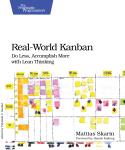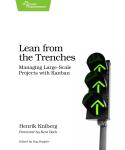About This Title
Pages: 102
Published: November 2015
ISBN: 9781680501285
Out of Print
Creating Great Teams
How Self-Selection Lets People Excel
by Sandy Mamoli and David Mole
People are happiest and most productive if they can choose what they work on and who they work with. Self-selecting teams give people that choice. Build well-designed and efficient teams to get the most out of your organization, with step-by-step instructions on how to set up teams quickly and efficiently. You’ll create a process that works for you, whether you need to form teams from scratch, improve the design of existing teams, or are on the verge of a big team re-shuffle.
Read the reviews:
Scrum
Expert
and
Larry
Price
And look at the InfoQ interview
Printed in full color.
Out of print
Discover how New Zealand’s biggest e-commerce company completely restructured their business through Self-Selection. In the process, find out how to create high-performing groups by letting people self-organize into small, cross-functional teams. Step-by-step guides, easy-to-follow diagrams, practical examples, checklists, and tools will enable you to run a Self-Selection process within your organization.
If you’re a manager who wants to structure your organization into small teams, you’ll discover why Self-Selection is the fastest and safest way to do so. You’ll prepare for and organize a Self-Selection event and make sure your Self-Selection participants and fellow managers are on board and ready. If you’re a team member, you’ll discover what it feels like to be part of a Self-Selection process and what the consequences are for your daily work. You’ll learn how to influence your colleagues and bosses to be open to the idea of Self-Selection. You’ll provide your manager with a plan for how to facilitate a Self-Selection event, and with evidence that the system works.
If you’re feeling the pain and chaos of adding new people to your organization, or just want to ensure that your teams have the right people with the right skills, Self-Selection will help you create the effective teams you need.
Q&A with Creating Great Teams authors Sandy Mamoli and David Mole
What is self-selection?
Self-selection a way of letting people choose which team to work in. It
is a facilitated process of letting people self-organize into small,
cross-functional teams. It is the fastest and most efficient way to form
stable teams and is based on a belief that people are at their happiest
and most productive if they can choose what they work on and who they
work with.
How is self-selection different from
self-organization?
Self-organizing teams are groups of motivated individuals who work
together toward a shared goal and have the ability and authority to take
decisions and readily adapt to changing demands. We like self-organizing
teams, but that’s not what this book is about.
This book is about self-selection, which is a process you can use to set up self-organizing teams in the first place. Self-selection happens at an organizational level rather than at a team level and is a way to get everyone into teams. Another term for a self-selected team is a self-designed team.
What are the advantages of self-selection?
From the data we collected we know that self-selected teams are:
- more stable
- happier
- more productive
- more motivated
Self-selection honors the principles of trusting people to be responsible adults who can solve complex problems and organize in a way that’s best for the organization and themselves. We believe that organizations get the best results when people can choose what they work on and who they work with.
How does self-selection work?
Organize a session where everyone gets together and chooses which team
they want to work in.
The process is iterative and facilitated and looks like the figure.
 :https://a.pragprog.com/cms/pip/mmteams1syano.png
:https://a.pragprog.com/cms/pip/mmteams1syano.png
What will people take away from reading your book?
They will learn how to prepare for and organize a self-selection event.
If they’re managers, they’ll learn how to convince their fellow managers
that it’s a good idea in the first place, and how to communicate with
their self- selection participants to make sure everyone is on board and
ready.
Developers, testers, BAs, UXers, and anyone else who does hands-on work will learn how to influence their colleagues and bosses to be open to the idea of self-selection. They will be able to provide their bosses with a plan for how to facilitate a self-selection event and evidence that the system works.
What You Need
Resources
Releases:
- P1.0 2015/11/16
Contents & Extracts
- Acknowledgments* *Foreword
- *Introduction: Self-Selection and Why You Should
Care
- What Is Self-Selection?
- Why Should You Care?
- We’ve Done It, and So Can You
- Who Are We?
- What Problem Did We Need to Solve?
- The Art of Stable Team Design
- Today’s Work Demands Stable Teams
- The Need for Speed
- The Science Behind Team Design
- What Next?
- Preparing for a Self-Selection Event
- Self-Selection at Scale *excerpt
- Step 1: Conduct a Readiness Check
- Step 2: Run a Trial
- Step 3: Get Permission
- Step 4: Define the Teams to Select
- Step 5: Coordinate Logistics
- Step 6: Communicate Early and Often
- What Next?
- Getting Ready for the Day
- Step 1: Define the Rules and Constraints
- Step 2: Create a Facilitation Plan
- Step 3: Prepare Frequently Asked Questions
- Step 4: Prepare Materials and Stationery
- What Next?
- Running a Self-Selection Event
- Step 1: Set Up the Room
- Step 2: Welcome People as They Arrive
- Step 3: Introduce the Day
- Step 4: Let Product Owners Pitch
- Step 5: Explain the Rules
- Step 6: Get people started: One, Two, Three, Go!
- Step 7: Conduct a Checkpoint Review
- Step 8: Rinse and Repeat
- Step 9: Tackle the Outstanding Problems
- Step 10: Wrap Up
- What Next?
- After Self-Selection: Now What?
*excerpt
- Making It Real
- Defining Squad Start Dates
- Kicking Off a New Squad
- Supporting Squads
- What Not To Do
- What Next?
- Insights
- People Appreciate Self-Selection
- Relationships Are the Deciding Factor
- People Respond Well to This Level of Trust
- What Next?
- Long-Term Effects of Self-Selection
- The Effect on Happiness
- The Effect on Squads
- The Effect on Managers
- The Effect on Productivity
- The Effect on the Company
- Now It’s Your Turn
- What Would You Do If You Weren’t Afraid?
Author
Sandy Mamoli is an Agile enterprise coach and consultant at Nomad8 with a focus on culture and leadership. From working in Amsterdam and Copenhagen to being one of New Zealand’s leading coaches, she brings her practical European flair and passionate advocacy for all things Agile to businesses around the world. Sandy is a former Olympian, a geek, a gadget junkie, and an international public speaker.
David Mole coaches, consults, and presents about Agile processes, teams, and motivation. He recently led an Agile transformation at Trade Me where, building upon the work of Spotify’s culture, he created dozens of high-performing Agile squads. He is a highly regarded public speaker and author for InfoQ. A former professional poker player, David works for Nomad8 helping teams and organizations perform better.
Out of print
Related Titles:
About This Title
Pages: 102
Published: November 2015
ISBN: 9781680501285
Edition: 1
Out of Print





